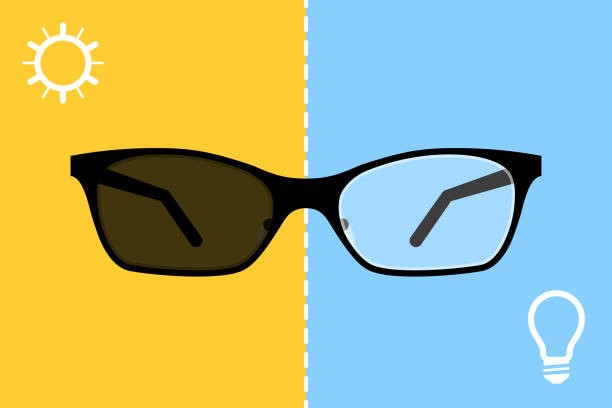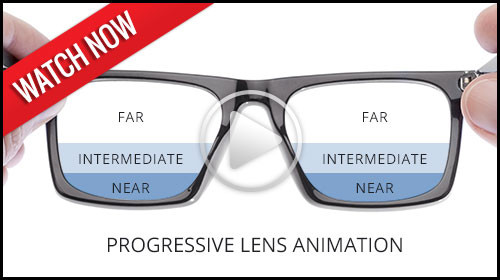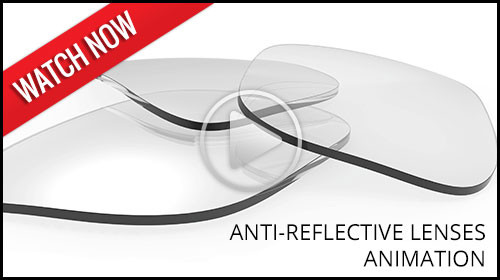Lenses & Coatings
Bifocal Lenses

For many people, different strengths are needed for seeing at different distances. Bifocal lenses allow the wearer to look through two areas of the lens: One area focuses on distant objects, the other is used for reading.
Progressive Lenses

One of the main problems with bifocal and trifocal lenses outside of the visible lines between powers is the issue of eye fatigue. It can be difficult to switch from one focusing power to another. Your eyes can tire, which can lead to a headache, sore neck and sore back. Patients have different visual needs in line with their varied lifestyles.
To solve this accommodation issue, the progressive lens was made. Progressive lenses provide a seamless increase in magnification from the top to the bottom of the lens, helping you see clearly at all distances with just one pair of glasses. Our progressive lenses are developed on the basis of precise measurement of individual prescriptions and simulation of perceived, real-world viewing fields, to deliver clear vision, with seamless gradation across all vision zones. Our progressive lenses identify the patient’s visual needs and are tailored to their Visual Age. It is intended for those demanding the most technologically advanced, precisely personalized lenses and those wanting the best lenses to optimally accommodate their individual prescription.
Trifocal Lenses
As the eyes age, a stronger prescription is often needed to read. The stronger prescription that allows for reading makes it difficult to focus on objects at intermediate distances, such as on the computer or your speedometer. Thus, trifocals were made to offer a third prescription for intermediate focusing.
Trifocals feature three areas of focusing power, each separated from the other by a distinct line. The three windows allow for focusing on distant objects, intermediately distanced objects, and for reading.
The downside of Bifocals and Trifocals is dealing with the lines between the different focusing powers. Fortunately, recent advances in technology have led to the development of the progressive lens.
Lens Materials
Midtown Optometry Prides itself in carrying the latest and most advanced lens options available, not only in our lens technologies but also in the lens material itself.
Polycarbonate
Polycarbonate is thinner and more lightweight than Plastic lenses, with added impact resistance and natural UV protection. Polycarbonate was originally developed for fighter jet cockpits and now is used mostly in Sunglass lenses and for Outdoor lifestyles.
Trivex
Trivex provides the perfect combination of optical quality, lightweight comfort, strength and protection—the critical performance characteristics called for in everyday living. Trivex has the impact resistance and inherent UV protection of polycarbonate. With a lower index of refraction, thus making it feel lighter on the face.
High-Index
High-index lenses are much thinner than Polycarbonate and Trivex. They are generally recommended for people who have significantly high refractive errors and strong prescriptions for nearsightedness, farsightedness, or astigmatism. High-index lenses have thinner edges even at high powers, which opens up a wider selection of frame styles for those with stronger prescriptions.Talk with your doctor to decide which high index lens is right for you.
Anti-Reflective Coating

 When eyeglass lenses reflect screen glare and other light sources, this reduces visual clarity and obscures others’ view of our eyes. Our anti glares are designed to effectively overcome this – so you can look good, see sharp and feel great. Anti-glare doesn't just solve unwanted reflections however, our anti glares improve lens durability, with added hydrophobic and anti static protection to prevent dust and smudging. At Midtown Optometry, our anti glares include extra UV protection both from the coating and embedded in the material that prevents harmful rays from being reflected into the eyes. It blocks UV from incoming light and light reflected off rear lens surfaces in all indexes. Anti-reflective coatings increase light transmission through the lenses to 99.5 percent. They make it easier to see and easier for others to see you. These coatings are especially useful for those viewing computer screens and driving at night.
When eyeglass lenses reflect screen glare and other light sources, this reduces visual clarity and obscures others’ view of our eyes. Our anti glares are designed to effectively overcome this – so you can look good, see sharp and feel great. Anti-glare doesn't just solve unwanted reflections however, our anti glares improve lens durability, with added hydrophobic and anti static protection to prevent dust and smudging. At Midtown Optometry, our anti glares include extra UV protection both from the coating and embedded in the material that prevents harmful rays from being reflected into the eyes. It blocks UV from incoming light and light reflected off rear lens surfaces in all indexes. Anti-reflective coatings increase light transmission through the lenses to 99.5 percent. They make it easier to see and easier for others to see you. These coatings are especially useful for those viewing computer screens and driving at night.
Photochromics

If you have ever felt frustrated at needing both prescription glasses and prescription sunglasses to accommodate an outdoor lifestyle, you should consider photochromic (also called Transitions) lenses. Photochromic lenses darken when exposed to UV rays, when the wearer goes outside when it's bright, the lenses darken automatically. When the wearer goes back inside, the glasses become clear. Transitions® Light Intelligent Lenses™ automatically adapt to changing light conditions to help to reduce glare, eye fatigue and strain – for effortless and relaxed vision in every situation. Transitions offer a choice of products tailored to your eyecare needs and are available in a wide range of stylish lens colors so you can express your own personal style. Empower yourself to take control of your light & enjoy always-on protection anytime, anywhere – indoors and out!


